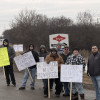Workers, public are at risk, says Transportation Trades Department
THE STRONGEST RAIL safety bill to be introduced in Congress in more than three decades is working its way through the U.S. House of Representatives. H.R. 2095, the Rail Safety Act, is aimed at reducing accidents, guarding against terrorist acts, and protecting workers from injuries and harassment.
“Rail safety laws should have been updated nine years ago when these laws were due for reauthorization,” Edward Wytkind, president of the Transportation Trades Department, AFL-CIO, told a House subcommittee earlier this year. Wytkind added: “Railroad lobbyists successfully blocked new safety laws while the freight railroad industry pocketed at least $25 billion in profits over the past six years.” He said failure to pass the bill would leave workers and the public at risk.
The U.S. railway system includes 230,000 miles of track. According to a CNN news report, more than 1,400 train accidents have occurred since 2003. In 2006, an accident involving a hazmat spill in South Carolina killed 11 people and injured 250.
“The Rail Safety Act is very important for our industry,” said Danny Hamilton, assistant director of the Boilermakers Railroad Division. “We have a big problem with harassment and intimidation. Essentially, if you are injured on the job you either go to a discipline hearing or sign a waiver admitting that you were guilty of violating a safety rule.” He said that situation has a chilling effect on reporting injuries.
Hamilton added that passage of the bill could mean additional work for railroad Boilermakers who inspect tracks and perform track welding at crossings. “Railroad tracks are in poor shape across the country. Passing the Rail Safety Act in its current form would mean more inspections and safety upgrades at crossings.”
Key provisions of H.R. 2095 include:
- Whistle-blower protections to encourage railroad workers to come forward with safety concerns.
- Regulations to end harassment and intimidation of workers who report personal injuries.
- Establishing training standards for all workers.
- Certification of train conductors.
- Protection of workers who refuse to authorize the use of equipment believed to be unsafe or hazardous to work with.
- Improvements in safety operations in “dark territory” (non-signaled track).
- Reduction in excessively long hours that lead to dangerous fatigue.
- Enhanced track inspection.






